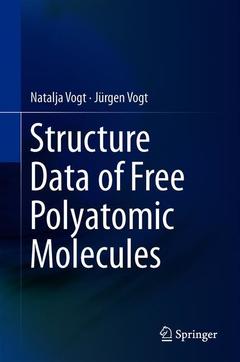Description
Structure Data of Free Polyatomic Molecules, 1st ed. 2019
Authors: Vogt Natalja, Vogt Jürgen
Language: English
Subjects for Structure Data of Free Polyatomic Molecules:
Approximative price 210.99 €
In Print (Delivery period: 15 days).
Add to cart926 p. · 21x27.9 cm · Hardback
Description
/li>Contents
/li>Biography
/li>Comment
/li>
This handbook presents structural data on free polyatomic molecules. Since the structure of molecules defines the chemical, physical and biological properties of matter, this information is crucial for understanding, explaining and predicting chemical reactions and biochemical processes, developing new drugs and materials as well as studying interstellar media.
Covering the structural data published between 2009 and 2017, this book supplements the previous Landolt?Börnstein volumes ?Structure Data of Free Polyatomic Molecules? (eds. K. Kuchitsu, N. Vogt, M. Tanimoto), which included data from the literature published up to 2008. It systematizes and describes peculiarities of molecular structures for about 1000 compounds studied mainly by gas-phase electron diffraction and rotational spectroscopy. All structures are given in three-dimensional representations.2. Introduction
3. Main methods of molecular structure determination
3.1 Gas-phase electron diffraction
3.2 High-resolution spectroscopy
3.3 Combined use of data from different methods
3.3.1 Gas-phase electron diffraction and rotational spectroscopy
3.3.2 Gas-phase electron diffraction and mass-spectrometry
3.3.3 Experimental and computational methods
4. Physical meaning of determined molecular structures
5. Uncertainties of structure determinations
6. Data representation in the handbook
6.1 Identification of molecules by registry numbers
6.2 Order of molecules according to chemical formulae in Hill system
6.3 Chemical nomenclature
6.4 Structure formulae and figures
6.5 Comments
6.6 Cross-references to Landolt-Börnstein volumes
7. References
8. List of abbreviations
9. Structure data of inorganic molecules without carbon atom(s) ca. 30
10. Structure data of molecules consisting one or more carbon atoms (mainly organic and organometallic compounds) ca. 200
AcknowledgementsNatalja Vogt studied chemistry at the Ivanovo University of Chemical Technology (Russia), receiving her diploma in Chemistry in 1978. In 1986, she received her Ph.D. in Physical Chemistry from the same university. From 1987 to 1989, she also studied physics at the Ivanovo State University and received her further diploma. Then she lectured physics, and from 1990 to 1991 was a postdoc at the Hungarian Academy of Sciences in Budapest. Since 1991 she has worked in the Section of Chemical Information Systems at the University of Ulm (Germany), since 2009 as a senior scientist. In 2012, she completed her habilitation thesis in physical chemistry at the Lomonosov Moscow State University on the topic “Determination of equilibrium structures of some biomolecules”. Since 2013, she has also been a Professor at the Chemistry Department at the Lomonosov Moscow State University and given lectures for advanced students in the field of structural chemistry. Since 1993, she has been a co-editor and/or co-author of the Landolt–Börnstein volumes Structure Data of Free Polyatomic Molecules (Group II: Molecules and Radicals; V.23, V.25 (A-D), V.28 (A-D), V.30 (A, B)). In 2003, she contributed to the four-volume Handbook of Chemoinformatics edited by Prof. Johann Gasteiger and Dr. Thomas Engel. She has written more than 100 publications including 12 Landolt–Börnstein handbooks.
Jürgen Vogt studied Chemistry at the Justus Liebig University in Giessen, and received his Dipl.-Chem. degree in 1978. He was awarded a Dr. rer. nat. degree in 1983 with the dissertation “High-resolution spectroscopy of instable molecules in the spectral range from the microwaves to the infrared”. In 1986 he worked as a scientific expert in the governmental air-pollution commission “Reinhaltung der Luft” at the association of German engineers (Verein Deutscher Ingenieure, VDI) in Düsseldorf. In 1987 he became a section leader at the Univer
Supplements the Landolt–Börnstein volumes Structure Data of Free Polyatomic Molecules
Is a unique source of critically evaluated structural data on molecules
Includes accurate molecular structures necessary to predict and explain chemical processes
Presents molecular structures defining the chemical, physical and biological properties of matter




